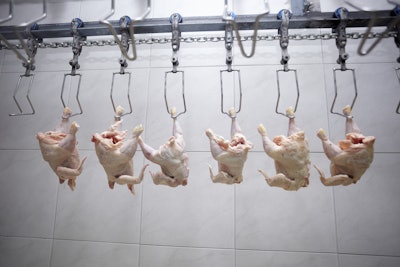
An approach that harnesses electrostatic technology to apply antimicrobial cleaners, disinfectants and sanitizers to poultry carcasses could help improve food safety and sustainability in the processing plant.
“The beauty of it is that it reduces water and chemical usage by 95%,” said Phyl Gaither-Murphy, marketing portfolio manager at Birko, a Diversey company.
The entire poultry supply chain is under tremendous pressure to improve sustainability and minimize the environmental impact of how poultry is raised, fed and processed. Water waste and water scarcity is also becoming a hot topic in the sustainability conversation.
What is electrostatic technology?
Electrostatic technology is a novel approach to applying cleaners, sanitizers and disinfectants to protect poultry products and improve food safety. The technique charges liquids as they pass through a sprayer nozzle. The droplets repel each other and instead seek out surfaces, resulting in a uniform coating and avoiding the liquid pooling often associated with trigger sprays.
“It ensures that all surfaces of a chicken are covered,” she added. “This means that you only need a little bit and that little bit goes a long way.”
Gaither-Murphy equates electrostatic technology to face cream, where a pea sized dollar is more than enough to cover an entire face. Electrostatic spraying goes farther than expected as well.
“It just gets rid of all of these complex parameters that are traditionally required within cleaning for poultry processing,” Gaither-Murphy said.
When used on poultry hanging on a conveyer belt, electrostatic technology can provide 360° coverage with a cleaning solution.
For example, in recent tests where peracetic acid (PAA) was applied to whole muscle cuts for 20 seconds, the 3.63 log pretreatment was reduced by up to 2.48 log post-treatment. Electrostatic technology has also been found to be effective against Salmonella and Campylobacter in turkey parts.


















